Food From Northern Laos, A Book Review/Lightroom 3.2, Processing a Glamor Portrait

|
• Costa Lanta Resort • Holiday Villa Hotel Koh Lanta • Langham Place Eco Resort & Spa • Lanta Casuarina Beach Resort |
I have some unfortunate news to report on this project and total 100% transparency is how I feel this should be handled. My planned beneficiaries of this project, innocent very much in need children at a certain orphanage, have fallen victim to their local manager who we have found cannot currently be trusted and I doubt this is likely to change. Decisions need to be made if we're going to carry this project forward and if so who the new beneficiaries will be. I do expect this project to generate significant revenue so I take it very seriously. As you read this I'll be back in the Mae Sot area investigating further. I'll keep you informed. For now I'll still collect images with the intention of making the best most meaningful mosaics possible and as always, I'm asking for and will greatly appreciate your help with the images.
We are still accepting (and pleading for) images of children from SEA. No matter how terrible you think
they are, please send them in anyway. These images will be used to complete a set of 3 high quality mosaics which will be sold to benefit the Karen and Burmese Orphans living in the orphanages and refugee camps. The more images the better, I can
use all you have. Please take the time to go through your images for anything you think might help. If you missed the "No Place to Call Home" special, you can
click on the link and read more about this. Thank you! info@BangkokImages.com
Quick Click Links
Feature Photograph
Food From Northern Laos, A Book Review Lightroom 3.2, Processing A Glamor Portrait
Photography News of Interest
Readers Submissions
Readers Questions A Snapshot of Bangkok Images Week in Review
Infocus Blog, You Have The Power!T
Feature Photograph *menu

Canon 1d Mark IV, 17mm F4L TS-E @F5.6 1/100th ISO 1600
A short time ago my friend Rob visited me and he’d just come from the local camera shop which justified the huge smile on his face. Eyeing the heavy bag from the camera store I queried “the new Canon 1d Mark IV?” He nods and then says “but that’s not all..” Soon he’d unboxed Canon’s new 17mm TSE (tilt shift lens) which is a huge chunk of glass, even bigger than my Canon 85mm F1.2L USM. I’ll admit it, as he was turning it over in his hands seeing it for the first time my fingers were itching and the desire to hold and examine this lens was overwhelming. He gave me that knowing smile, not quite sure if he understood my desire to see this masterpiece, or perhaps he was just feeling a bit of sympathy because I haven’t yet added it to my own lens collection, and then passed it over to me where I gave it a good look. What can you say when you observe a talented photographer unwrapping a great new camera body and lens? Easy. “I can’t wait to see the pictures!”
This butterfly was captured in Surat Thani and is one of the very first “test” images from his new Canon EOS 1d Mark IV. We need to take this in context. Such shots are usually painstakingly captured with a tripod mounted camera, external shutter release, macro lens, and usually an external strobe. This image was captured hand held, on a whim, with nothing more than a good observant eye. The Canon 1d Mark IV did a great job at high ISO's. And it's darn near perfect. The butterfly head, body, and antenna are in sharp focus allowing it to stand out from the rest of the colorful scene which is fading into a very nice bokeh.
I’m not a fan of insect shots, but I know when I like one. The angle of the insect is perfect, the yellow flowers give a pleasing yet sharp contrast, and the green leaves provide another layer of color. Properly processed it really presents well. Maybe next time he'll share some shots using the 17mm F4L TS-E.
This is what you can expect from all of Rob’s work if youvisit his site and take a gander around. Or, you can join him on our site for a African Kruger trip report parts one and parts two , or maybe join him on the Great Wall Of China? or read his interview here.
Food From Northern Laos, A Book Review *menu
A few years ago I had a request from a client, Kees Sprengers, to help him color profile his Imac and introduce him to Lightroom 2.xx. He didn't request hands on instruction with the camera and after requesting and receiving several of his images I understood why. This man knew his way around a camera! During our workshop we discussed his goals of writing a book on some topic concerning Northern Laos. Late last week via post I received a copy of his new book "Food from Northern Laos, The Boat Landing Cookbook!" I spent a few hours reading this book and immediately knew I wanted to share it with you in this column.

Yes, this is a photography column and I’m reviewing a cookbook. Stay with me a bit and I’ll explain. First, the book is heavily pictorialized with some of the better images you’ll see of northern Laos and the images really give you an insight into the Lao people and their culture. Second, the writer, Dorothy Culloty, has done a great job in the opening chapters with the historical background, and throughout the book you get more of a family story telling feeling than you would from your typical cookbook. So to me, this is much more than just a cookbook.

Much of Kees Sprengers photography take place inside dark living quarters with no artificial lighting, and many of these by necessity are high ISO captures which press the capabilities of modern photography equipment. Because he documented this project over a seven year period he’s went through several cameras, from a once popular Sony point and shoot, to Canon’s latest EOS 5d Mark II. If I have a criticism at all, it would be that I wished he’d have included his exfil data in captions so interested photographers could take note.

The opening section explains much of their history in Laos, and how they came across the Boat Landing Guest House and Restaurant and became part of their family. The Boat Landing is in the Luang Namtha province and is literally where the boats must land/dock because they can go no further as the river shallows out and the journey now becomes overland.

Above is the Boat Landing Guest House and Restaurant which prides itself as a type of ecotourist destination. You’ll enjoy reading about the Boat Landing in the book and the history of the family who runs it. The family is quite large and much effort was made to allow their guests the most comfort, with the least impact on the natural landscape.
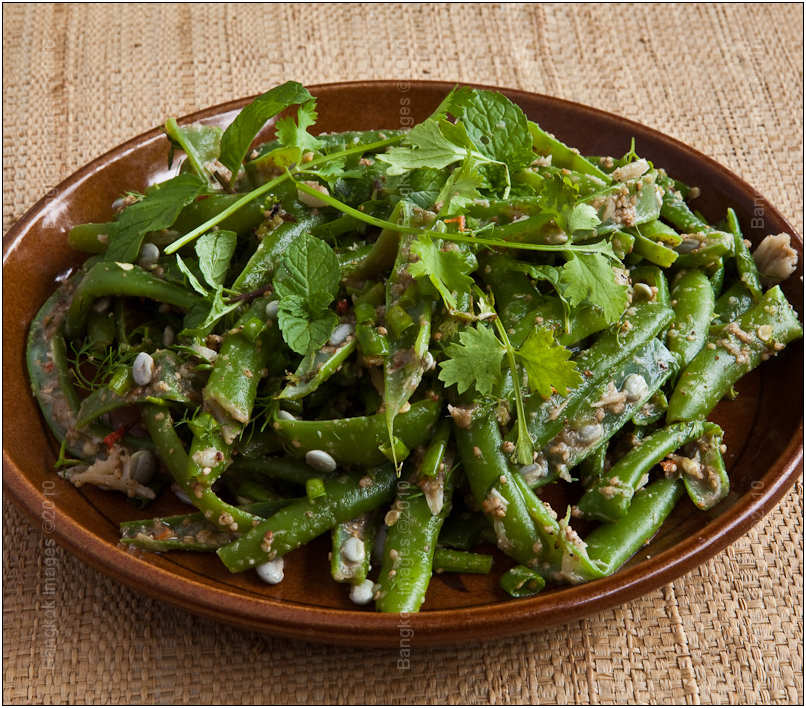
Throughout the book you’ll see detailed pictures of the completed dishes and the ingredients to make them. The section on ingredients is very impressive. Detailed pictures will help you identify ingredients by sight, while different names are listed with ways to know the small differences which would prove helpful as well. Often sourcing ingredients, especially for foreign dishes, is a major chore. Their in-depth guide on the ingredients will make the sourcing of ingredients much easier.
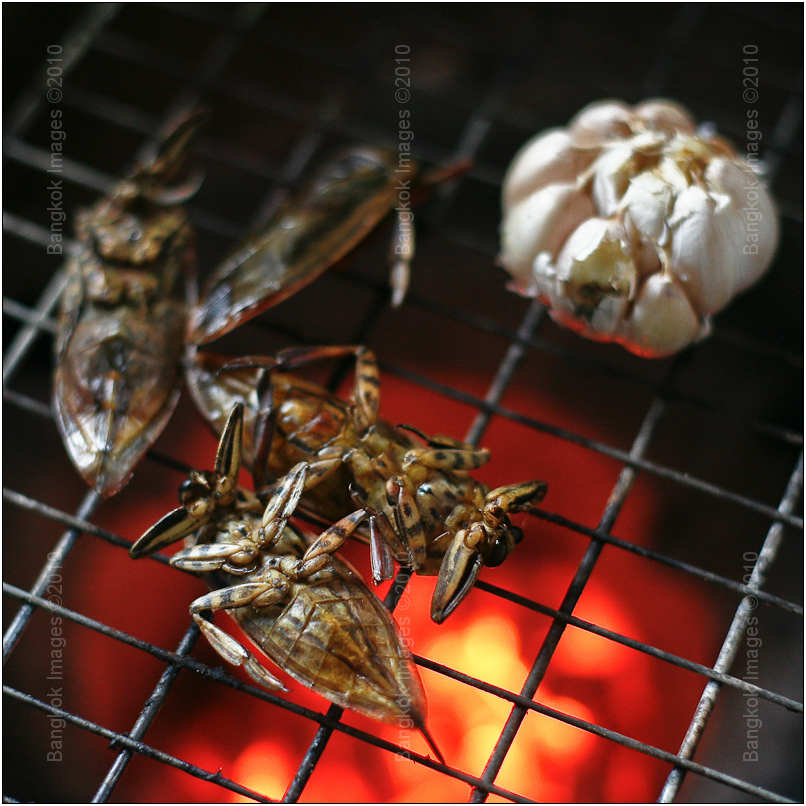
Nothing is sacred in this book so you’ll find how the local insects are used for seasoning in sauces or grilled as snacks.
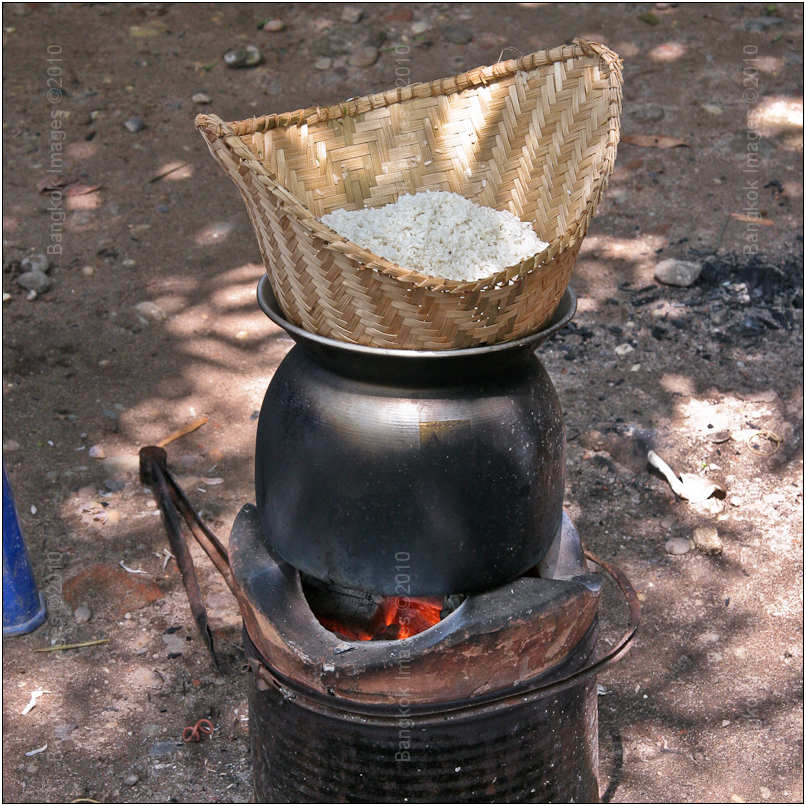
Cooking implements can be another obstacle, but here they’ve provided great pictures of what the locals use, and talk about modern kitchen substitutes and techniques so you can be sure to complete your recipe.
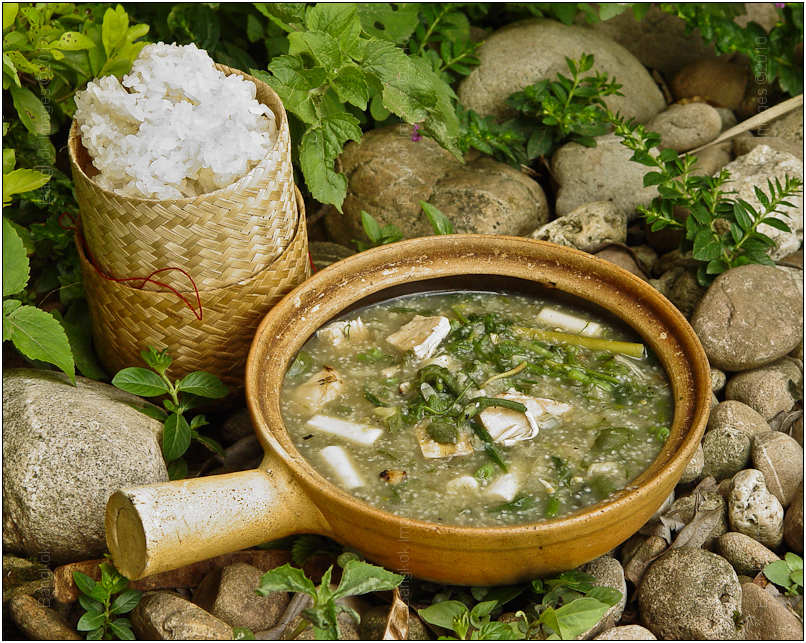
From history, to culture, and ingredients to recipes, you’ll find this book as much of an encyclopedic resource as any available. Anyone familiar with Asian recipes knows original recipes don’t make use of the standard measuring spoons and cups but instead use pinches and dashes and palm measures. The amount of work that went into converting the local portion sizes to western measures had to have been huge, but it’s been made easy for the reader with clear measures and definitions.
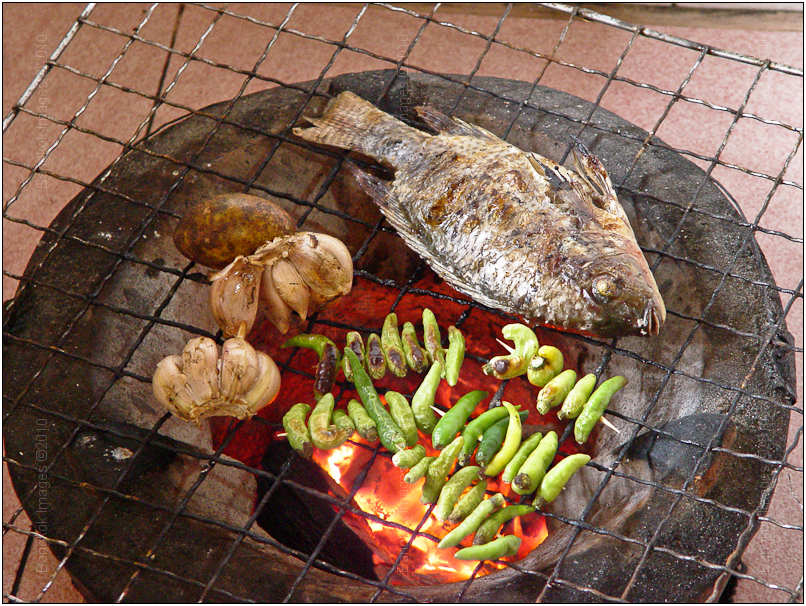
As you hit the recipe section you’ll find them in order of dipping sauces, stews and soups, stir fry, stuffed, steamed, grilled, salads, rice, sweets and drinks. Everything is here! This has got to be the most complete work on Northern Laos recipes available anywhere!
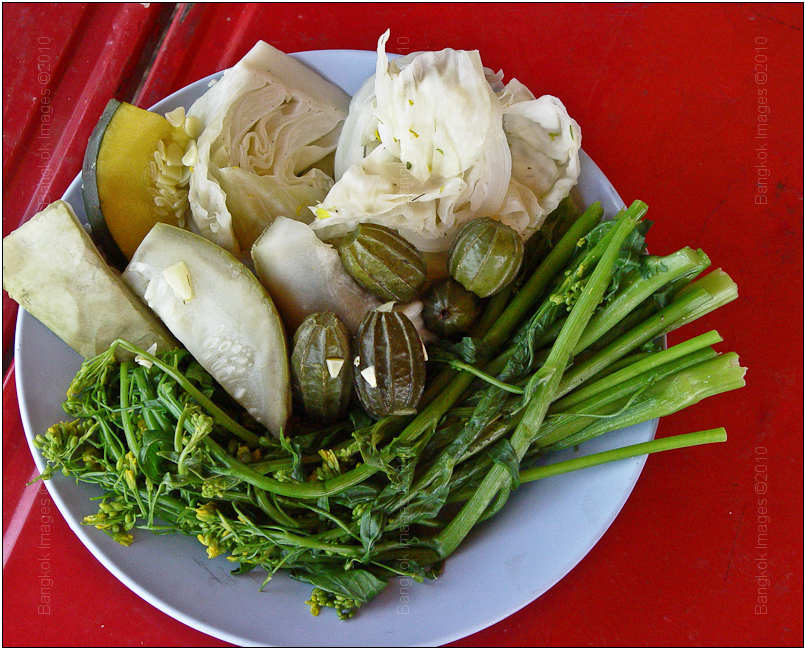
Many of the pictures show attractive prepared dishes full of freshness and color you rarely see. Looking at the prepared dishes you instinctively know these are healthy natural foods which would benefit anyone’s diet. You almost feel like you can reach into the image and pop a vegetable into your mouth and taste it.
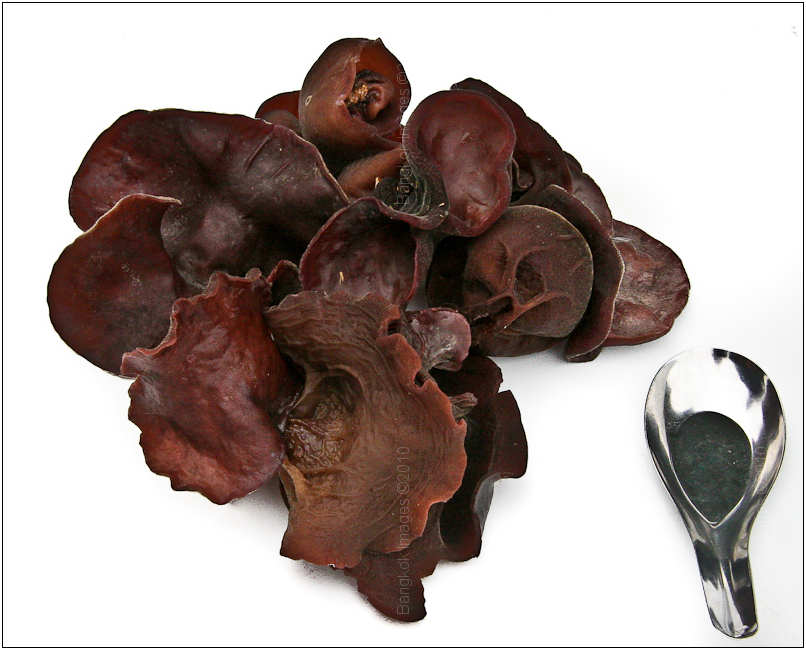
It’s close up and detailed pictures such as these which will prove extremely helpful in finding the right ingredients. The grocery stores in the west often mislabel or misidentify Asian ingredients and I’ll never forget many years ago when my Korean mother-in-law visited my small ranch in Oregon and immediately went into the surrounding forest and came back with a basketful of ingredients to use for Korean cooking.
I was baffled, “this is Oregon” I said. And she’d just look at me like I was the most clueless individual alive and patiently explain how much of Asian produce grows wild and not in the neat cultivated rows we westerners associate with our own produce. “You must learn to eat what the land provides naturally” she’d tell me. Of course this makes sense, anyone traveling throughout a rural South East Asian countryside has seen this many times, but perhaps haven’t put the pieces together. One day I’ll dig out the images I have of her blackberry wine making process and tell you how we enjoyed an unlimited quantity of fine wines and how she financed her trips overseas.
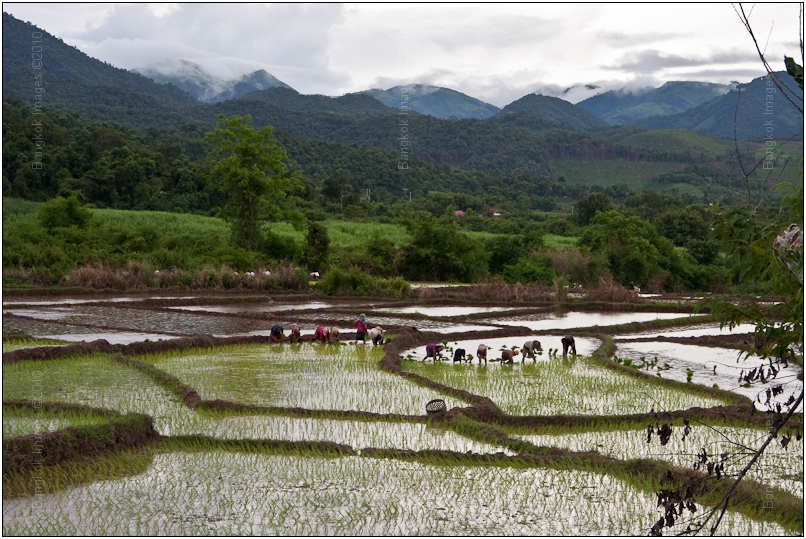
Cooking aside, my favorite part of this book, and the reason I kept picking it up over and over again is for pictures like the one above. Wonderful compositions with a true feeling for the cultural landscape. How do I know? Because I’ve also spent nearly a decade of my life in SEA areas and the images help me feel at home.
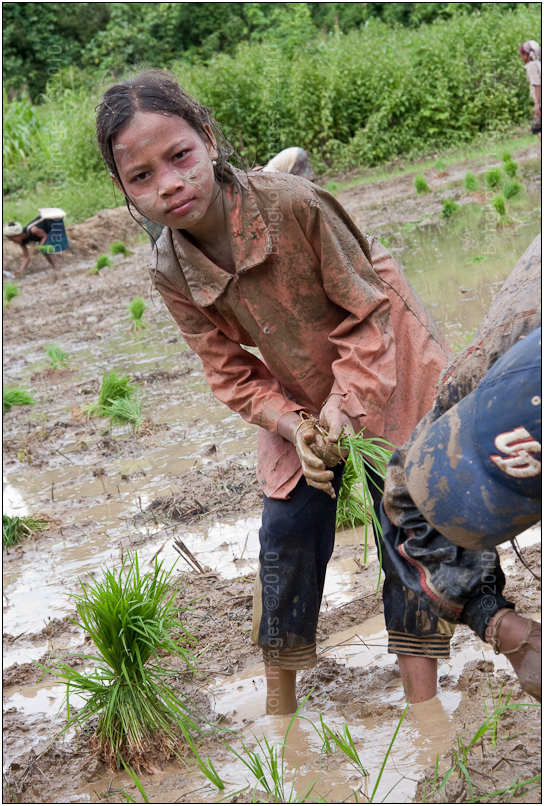
I’ll be sharing this book with my children. They’re not interested in Northern Lao food in the least, but it’s been my experience when they visit SEA countryside’s and observe children their own age working all day in rice fields or cutting the heads of fish, that they tend to adopt a different perspective on their own life. You’ve read my experiences with my son at the Mae La Refugee camp and Safe Haven Orphanage and other such places, and I’m 100% convinced its helped provide a perspective responsible for his hard work at school and his natural kindness and respect for others. Food From Northern Laos will help do the same for your children.
Thank you to both Kees and Dorothy for allowing me to be one of the first to appreciate their new reference book on Northern Lao foods. I’ve enjoyed the book and my Thai wife is eager to try some of the recipes. I can also think of a few friends and family who will appreciate a copy for Christmas. A quick scan of the barcode using my newHTC Desire Android phone reveals the book can be purchased from Amazon at this link. You can also order it directly from their website here.
No review would be complete without at least one legitimate criticism and I’ll admit I had to look hard and I’m probably nitpicking, or perhaps it’s my old eyes, but I do wish the print was larger.
Note: During the process of writing this review I wanted to know more about the sweat and hard work that goes into a project of this scope, about the publishing choices and other necessary decisions. And more, what would make a middle-aged couple from New Zealand spend 7 years of their life in such a rural environment. So I asked them over for an interview! You can read it here next week. ;o)
Lightroom, Processing A Glamor Portrait *menu
The other week I had a client who wanted to learn how to take better portraits, work with a model, and use different lighting techniques. We worked together for the day and employed a model I use who is patient and a lot of fun to work with. We started by going over the different lighting equipment and techniques, talked about working a model, and then went to work shooting the model. During the session we tried several techniques ranging from the easiest which would work during a fast paced event, to the more involved when we have the time to work making a great photo. We used different lenses, different flashes, and many different environments. The end result being that the client learned which equipment and technique would suit him best in which environment.
You might recognize the model from a previous piece where we processed a similar photo using a similar technique , and a piece on the modeling experience itself. The interesting part of this, and the reason for the follow up, is it was interesting to me how much new equipment and software has changed in the six months since the last piece. Nothing major, but small bits and pieces which can make a significant difference if used correctly. This is a different type of shot using different lighting, the same equipment, and a different student. The first was captured outdoors in the daylight, the other indoors using window light.
Let’s go through the processing process together and maybe this time you can pull up an image of your own into Lightroom 3.2 and follow along with the different steps? If you do, I can almost promise you that in 10 minutes time you can duplicate the processing I used for this image. It’s notable that this image was captured using a Canon 5d Mark II with the original 85mm F1.2L USM lens at F1.2. Wide open.
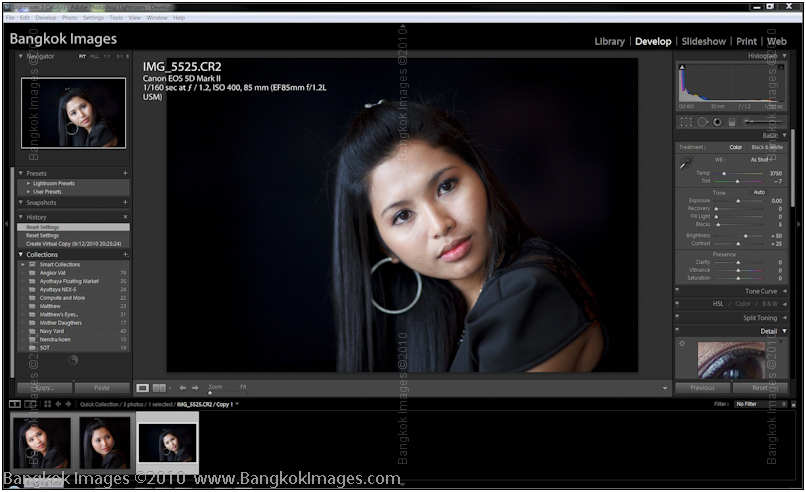
In the image above is the original untouched image. Notice how the photographer achieved a perfect exposure? We were also learning to use an old fashioned hand held light meter..;o)
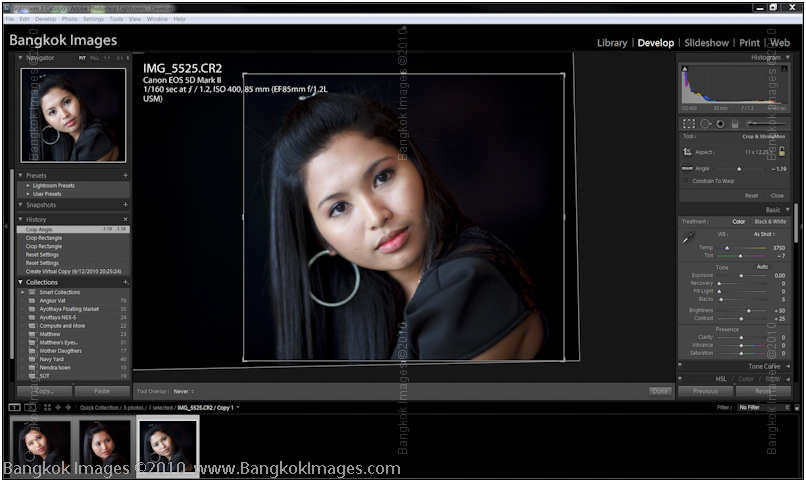
Here we mark out our crop lines. I recommend doing this before making exposure or white balance adjustments because the part of the frame you’re cutting out will no longer be affecting your histogram display. Cropping is mostly a matter of taste, but I think this works well with this particular image.
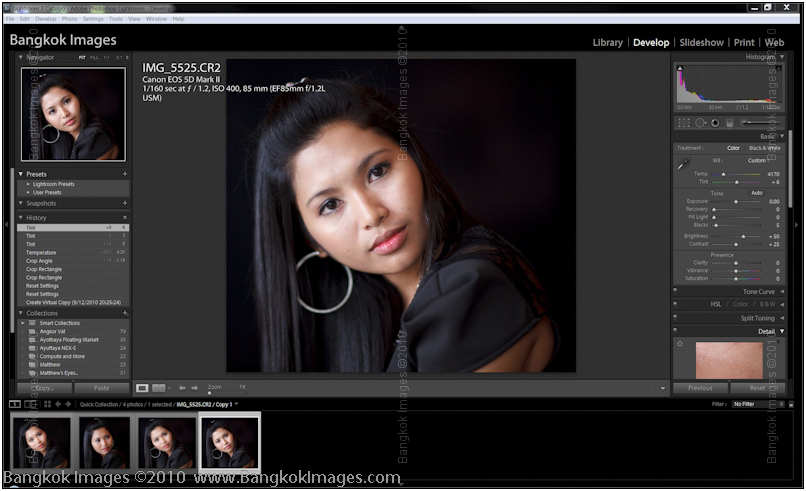
Here we have the cropped image and noticing the white balance was off we warmed it up a little and adjusted the hues. This is always tricky no matter how much experience you have and it’s why I recommend using theXrite Color Checker Passport I reviewed here. We did make the Color Checker part of our lesson plan, but we hadn’t yet gotten to it at the time of this image.
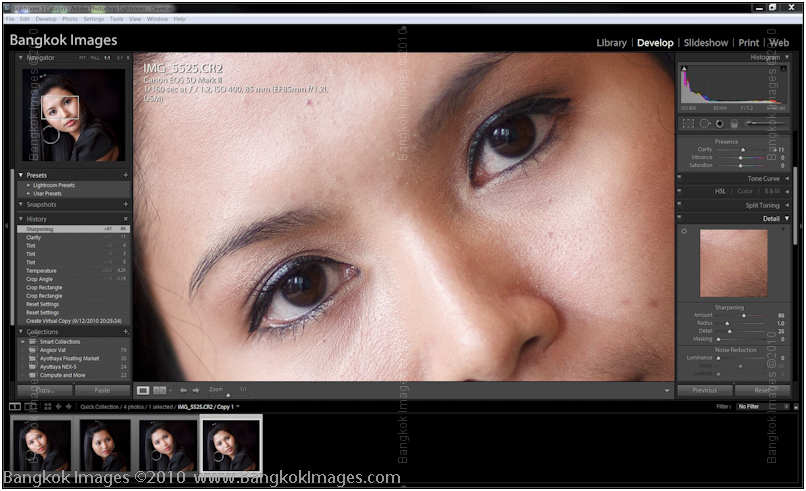
Next are the eyes. You can tell a person’s age (and how hard they live) by careful study of the whites of their eyes. As a person ages they get less white. No matter how much plastic surgery someone has they can’t change this one thing. I zoomed in on the eyes to study the sharpness and was pleased he was able to achieve critical sharpness wide open at F1.2 Many photographers will try and tell you this lens isn’t sharp at F1.2, and doesn’t get sharp to F2. I’ll let you gaze a this zoom of her eyes (the focal point) and let you be the judge.
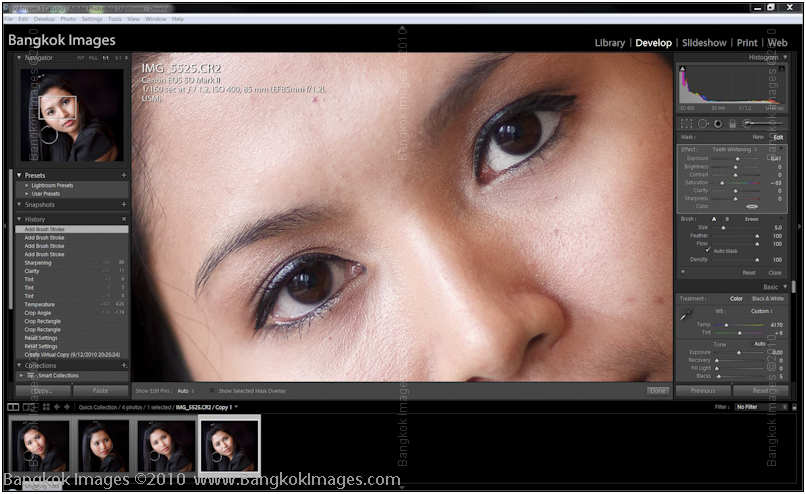
Now we select the “Localized Editing” brush and choose the “Teeth Whitening” preset. Teeth or eyes, it works well. Notice the eye on the right is done, and the eye on the left is undone? Notice the difference? You don’t want to go ‘too white’, try to keep it natural and just take a few years off your subject. Caution, a 40 year old woman with very white whites doesn’t look younger, she’ll just look freaky. Be judicious.
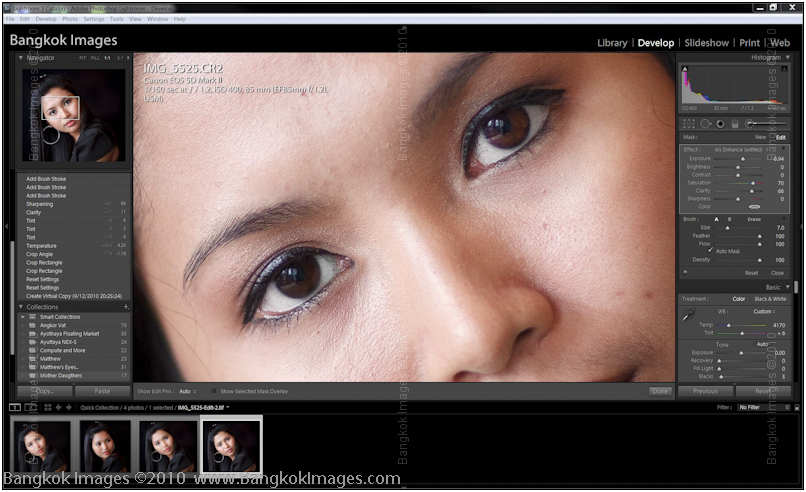
After selecting another localized editing point we choose “Iris Enhancement” and bring out the color in her eyes. Again, the eye on the right is done and the eye on the left not done. Notice how subtle the differences are? Your instinct will be to do too much, go too far, but resist. When in doubt do less.
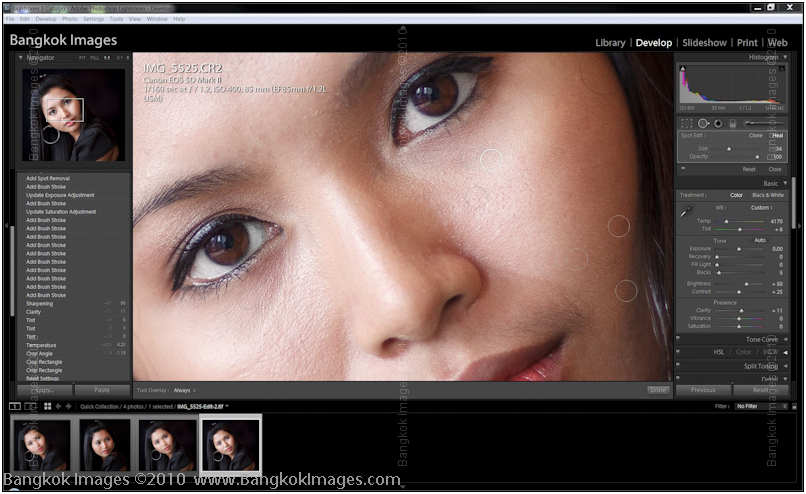
With both eyes complete we choose the ‘spot healing’ brush (the circle with the arrow exiting the ride side of it) and remove any pimples, blemishes, or spots. See the light circles? These are areas I removed very small blemishes.
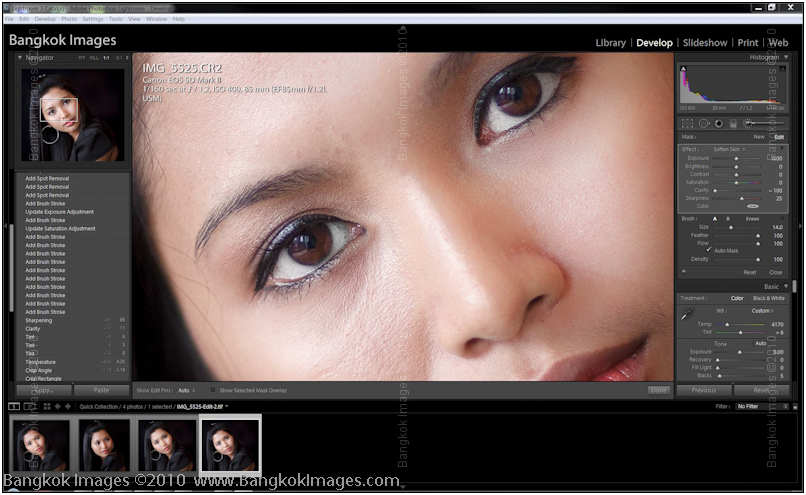
In this image we’ve selected another localized editing point and the “skin softening” preset. The right side of her face is softened, the left side isn’t. Look under her eyes and on the cheek. See the difference? Again, you don’t want to go too far.
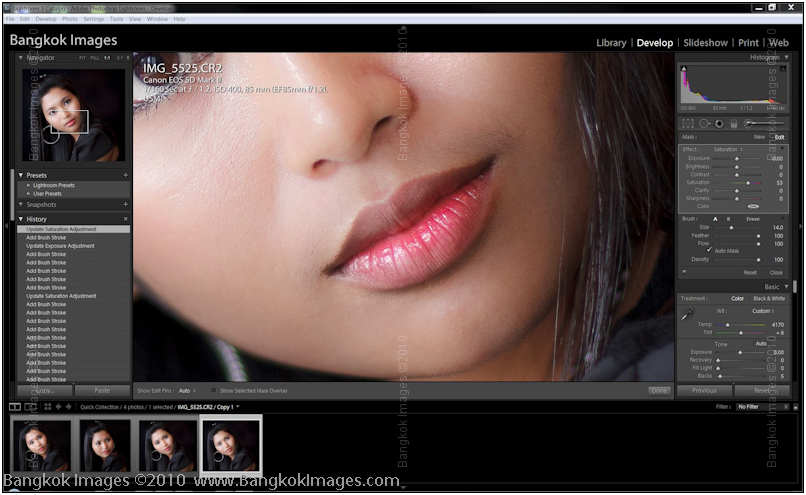
Select another localized editing point and the “saturation” preset. Now you can slightly increase the color on her lips. Again, for purposes of demonstration I only completed the right side of her lips so you could see the difference.
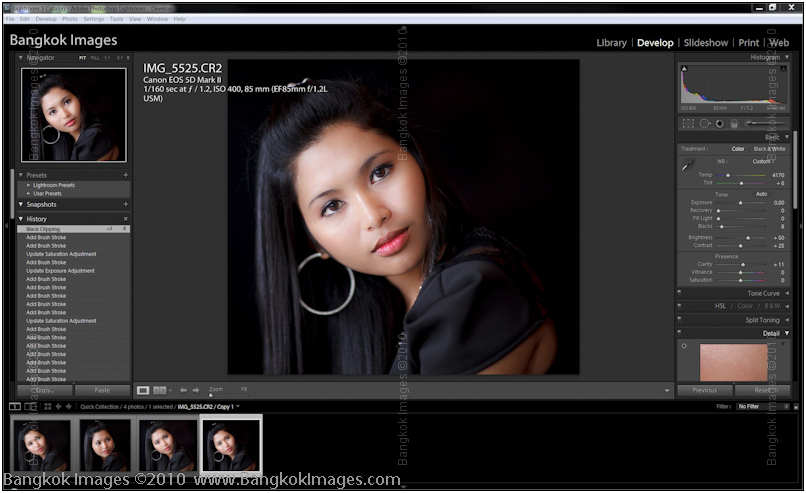
Zoomed back out to a normal view we can see everything is done. The only addition step I did was to increase the black level a bit to add more contrast.
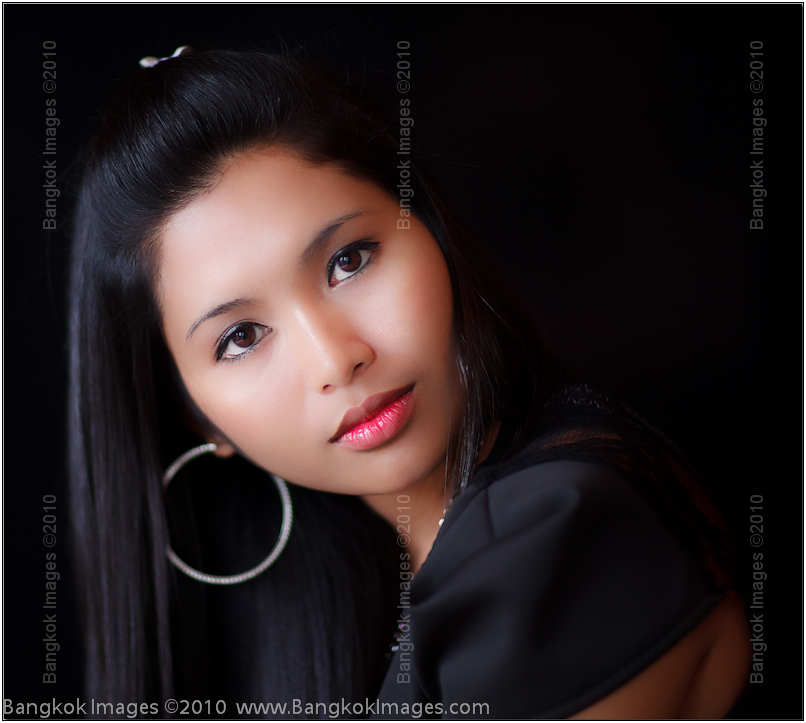
Looks good, eh? This 800 pixel image is far from a ‘full size’ image, but it's big enough to see we’ve really made some changes. By design each change was subtle, but when you put them all together the effect can be dramatic. Remember, the enemy of good is better. Too much ruins the image and makes it look amateurish. When in doubt, go with less.
I hope you’ve followed along and are now able to do the same. It’s not as hard as it looks and it's easily something the average person can do in just a few minutes. Sure, there’s more complex ways to do the same thing in Photoshop, and a plethora of Photoshop plug-ins you can spend your money on for marginally better results with a lot more work, but if you’re using Lightroom already you might as well take advantage of its features.
Is there something else you’d like to know how to do? Send me an email and I’ll work up another tutorial.
Photography News of Interest *menu
With a name like “Ms. Eastman” catching my name I was astounded to learn she ran up much of her $170,000 student loan balance on her bachelors in photography degree!
You could go to medical school for that! Well almost, Ms. Tidwell will run up a $250,000 student loan debt becoming an emergency room doctor. This article is about how ‘hidden debt’ can ruin relationships, but Ms. Eastman’s
$170,000 bachelor degree in photography really set me back in my chair!

This is indeed welcome news.
Zeiss will be making compact prime CP.2 (cine) lenses in the Sony Alpha mount (Sony NEX-3/NEX-5 and their NEX VG10 HD Camcorder) and for the Micro 4/3’s system. It will be great
having high quality Zeiss primes available for my little Sony. I just hope they make them fast too!
Are you a fan of Pentax? Many are, and Digital Photography Review just did a “hands-on” their mid-level DSLR the Pentax K-r. This looks to complete directly with the Nikon
D3100 and Canon T2i. Check out the review here.

Interested in a medium format digital Pentax 645D? Nick Devlin provides a First Look over on the Luminance Landscape website which includes a 15 minute video interview discussing the camera with Pentax Canada. If you’re interested in such a beast, this is a great article.

Photography isn’t a crime. Or is it? In Miami theMetrorail guards actually attacked a photographer for photographing their premises. The local paper calls their guards bullies who are ignorant of the law. Sounds a lot like the guards at Pantip Plaza!
A former rock n’ roll photographer takes on the subject of Islam. Peter Sanders, a Muslim convert says he’s trying to show the true face of Islam through his photography. He’s photographed everyone from Bob Dylan though Jimi Hendrix. I have to ask, is photography as illegal in Islamic countries as it is becoming in the UK, USA, NZ, and Australia as I’ve reported in this column? Are the guard bullying photographers and ignorant of the laws?

Readers Submissions *menu
Steve,
Thanks for the information about the camera. It's a dandy and I'm going to look at it. Here are a couple of pictures of the cobra I told you about….taken with my little point/shoot Lumix. I was about 3 feet from him when I took it.
Regards, Dick



Dick –
This reminds me of the old adage: “What’s the best camera?”
Answer: “The camera you have with you when you need to take a picture..”
What a great capture, and even better that it was unexpected. Thanks for the submissions!
Steve
I suspect the readers submissions will be a highly anticipated section of this column and I encourage anyone with photographs and travel accounts they'd like to share to please send them to me at: info@BangkokImages.com
Readers Questions *menu
Steve,
I would like to get a new monitor but I’m not a professional photographer so I don’t need the best. Just something that would let me match color for printing. Is there anything out there at a reasonable price?
Thanks Steve
Jeff
Jeff –
We have more choices today than ever before, and better prices. If you’re a serious photographer I’d try to talk you into a premium monitor, but for most hobbyists it wouldn’t be sound advice. If you’re a hobbyist photographer look for something with an S-IPS display in the biggest size you can afford. The more screen real estate, the better. There are currently two monitors in this category I’d give serious consideration to. The Viewsonic VP2365wb which is a 23 inch 1920×1080 display featuring an S-IPS panel. It’s about $298 on Amazon but I’m not sure on the price here in Thailand. I do know they have a great Viewsonic service center here though. The other would be a Dell U2410 which might be a bit better which offers a 24 inch 1920×1200 screen with a S-IPS panel. It’s about $499 on Dell’s website, so quite a bit more. Personally I’m thinking of trying out the Viewsonic VP2365wb for a travel monitor. And let’s not forget you’ll need to color profile ANY monitor you buy.
I hope this helps
Steve
BKKSteve.
How should you use the histogram? I’ve heard it’s something you should always do, but I don’t understand how to use it.
Thanks!
Eldon
Eldon –
A full explanation would require more space than this area of the column, so let’s stick to the most important points and then I’ll also refer you to this article I wrote called "Expose To The Right" a while back which is a lot more complete with examples and more.
Expose to the right is a great way to remember. Your histogram is composed of 256 vertical segments labeled 0-255. Each segment corresponds to a light value with 0 being dark and 255 being the brightest your sensor can record without losing information. The ‘shape’ of your histogram simply reflects the scenes luminance composition, or how many light and dark areas are in the scene.
Knowing that digital sensors are like slide film, in that any area of the frame you overexpose is totally lost. So, expose to the right merely means expose as far to the right as you can, without touching or going over the 255 value. In real life this means there should be a small 1/16th inch space between end of your histogram reading and the furthest right of your histogram itself. Read my article to see the visual representations of this.
If you can understand and expose your images in this manner, you’ll soon end up with perfect exposures.
I hope this helps
Steve
Please submit your questions to info@BangkokImages.com All questions will be answered and most will show up in the weekly column.
A Snapshot of Bangkok Images Week in Review *menu

This week there were two workshops, and more work and improvements on our website . This week marks our second week of being independent. This means I’m now maintaining the site 100% myself and we’re on our own new server. The week before we did the transfer to a new server and sorted out a plethora of small issues. This week we continued our work by updating both our blog modules and gallery software. We have some fine tuning to do before we bring the new features online, but we’re getting close. I’ll announce and point you at the new features once they’re ready.
If all goes well I’ll be in Mae Hong San most of the last week and will be back in Bangkok early the next. We’ll tackle those new features on the website then.
The "What's New" area of our site continues to grow in popularity and the numbers are growing. The forums could use more activity, so if you want to meet more like minded photographers or just ask a question check them out. We try to update the What’s New page several times a week and provide either an interesting new image or something of interest. Check it out to keep track of Bangkok Images exploits and commentary throughout the week.
Still a ton of hardware and software reviews being formed. Please be patient, we have a lot coming and only so much space in the column each week to post it.
Infocus Blog, You Have The Power! *menu
Nah, I’m not talking about Iron Man or some other Marvel Comic super hero. I’m talking about you as a consumer. Your feedback to those places where you spend your money will largely determine your future experience with these same establishments.
A bit of background: I listen to a lot of people living or visiting here complaining. They complain about the taxi drivers, the food venders, the airline they flew in on, and the hotels where they stay. It seems as if a conversation isn’t complete
unless a large part of the conversation is spent complaining. Yet, when I ask this simple question I’ll almost always get the same look. The question: “What did you do about it?”
Oh my, that connotes that you as the consumer actually has some responsibility in how you’re treated. The dreaded R word is one no one wants to hear. Yet, it’s unavoidable if you really expect any type of improvement.
You as a consumer need to be actively engaged, plugged in if you will, to the consumer network on every level. This isn’t much different than your responsibility as a citizen of your own country concerning politics. What, you don’t
have much to do with politics? You don’t vote? You don’t write letters to your representatives? Shame on you. How will things ever change if your politicians never know exactly how strongly you feel about certain issues? And how
will the people you do business with ever know how important certain issues are to you if you don’t tell them?
Example: I have a new favorite place to enjoy lunch. They have great food, reasonable prices, free wi-fi, and it’s a very comfortable place. I go there to eat, check my email, read, and generally have a relaxing time. One day I go there and the
music is cranked up. Not the way music normally gets cranked up in Thailand, but still it was loud enough to be distracting. I looked around and I was the only customer. It was the employees who were enjoying the music. Personally I think it’s
a bad idea to allow control of the sound system to your employees but that’s beside the point.
What did I do? Did I sit there and become more annoyed never to return again? No. I have a type of investment in this place as a consumer. I’ve been there many times and want to go back many more. I had to exercise my responsibility as a consumer.
Even when I knew the employees would be annoyed with me. I asked to speak to the manager and when she came I asked a simple question: “Do you appreciate my patronage?” She said she did, she listened to my feedback,
and I’ve never had the problem again. Sometimes the employees will even politely ask if the music is too loud. Yes, this happened in Thailand, the land of lost hearing.
Another example: I had a great experience at a computer shop. I could have walked out and not said a word. But I had such a good experience I envisioned myself going back again. So I took a minute and asked to speak with the manager and I thanked him
for making my shopping experience so great and I let him know I’d be coming back because of it.
Sometimes it’s a major PIA to get through to someone at the right level. Do you know I have the personal mobile phone number of the President of NEC Thailand? I couldn’t get any of the lower level employees to understand how I expected to
be treated as a customer who spends a large amount of money. A few days, many emails, and several phone calls to NEC Japan and America had the situation straightened out. No, I didn’t want to go through the hassle. But I wanted a local
NEC dealer that I enjoyed doing business with.
My guess, is if we as consumers put as much time and energy into providing feedback as we do complaining, we’d end up having a lot less to complain about. What do you think?
Until next time..




